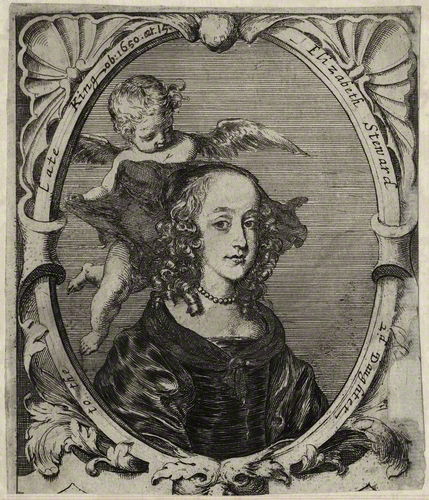 |
| via Wikimedia Commons |
When the English Civil War broke out, what once had been a close and unusually loving royal family was physically split up. The five surviving children of Charles and his French Queen Henrietta Maria would never be all together again. (A sixth child, Henrietta Anne would be born in the midst of the war.) Elizabeth was six years old. Parliament took over custody of her and her younger brother Prince Henry Duke of Gloucester and insisted that they be reared as Protestants in contrast to their Catholic family. They were shifted among various locations over the years, sometimes joined by their older brother The Duke of York (later King James II). Frequently, they were an unwanted burden for their caretakers.
Nevertheless, Elizabeth received an excellent education. She was particularly well-versed in religion and was able to read and write in many languages, including Ancient Greek, Latin, Italian, Hebrew, and French. She frequently wrote eloquent letters to request changes in her treatment. At age 12, she wrote to request that her household (her servants) not be removed from her, as had been planned. Parliament relented, allowing her to keep her quasi-family around her.
Renowned for her sweet and calm temperament, Elizabeth struggled with health issues. Centuries later, her body was examined and found to have suffered from rickets, knock knees and pigeon toes. These deficiencies led to at least one seriously broken leg.
Her most heartbreaking moment came when she and Henry were allowed to say goodbye to their father as he awaited execution. They had seen him periodically over the years, and loved him dearly. Twelve-year-old Elizabeth stoically recorded as many details of their final meeting as she could remember. He sent his love to their mother, encouraged them to be good Protestants, and warned young Henry not to become a pawn king in the hands of Parliament: do not let them crown you while your older brothers live.
The sobbing children were led away into an even worse political situation. No longer children of the king, they were at the mercy of their guardians, who could not treat them very well lest they be seen as committing treason against Parliament. When their oldest brother swept into the country to have himself proclaimed king against Parliament's wishes, it was decided to move Elizabeth and Henry to the distant confines of the Isle of Wight. Elizabeth, ill at the time, wrote again to Parliament begging not to be moved because of her health. Her pleas went unheard. After the move, she developed pneumonia and died. She was 14.
For two centuries, her grave was marked simply by her initials, E.S., until Queen Victoria made the Isle of Wight her main home. She erected a monument depicting the young Princess, whose dead body had been found resting on the Bible that her father had given her during their last tear-filled meeting.
For more about Elizabeth:
Elizabeth Stewart - The Lost Princess on Madame Guillotine
No comments:
Post a Comment